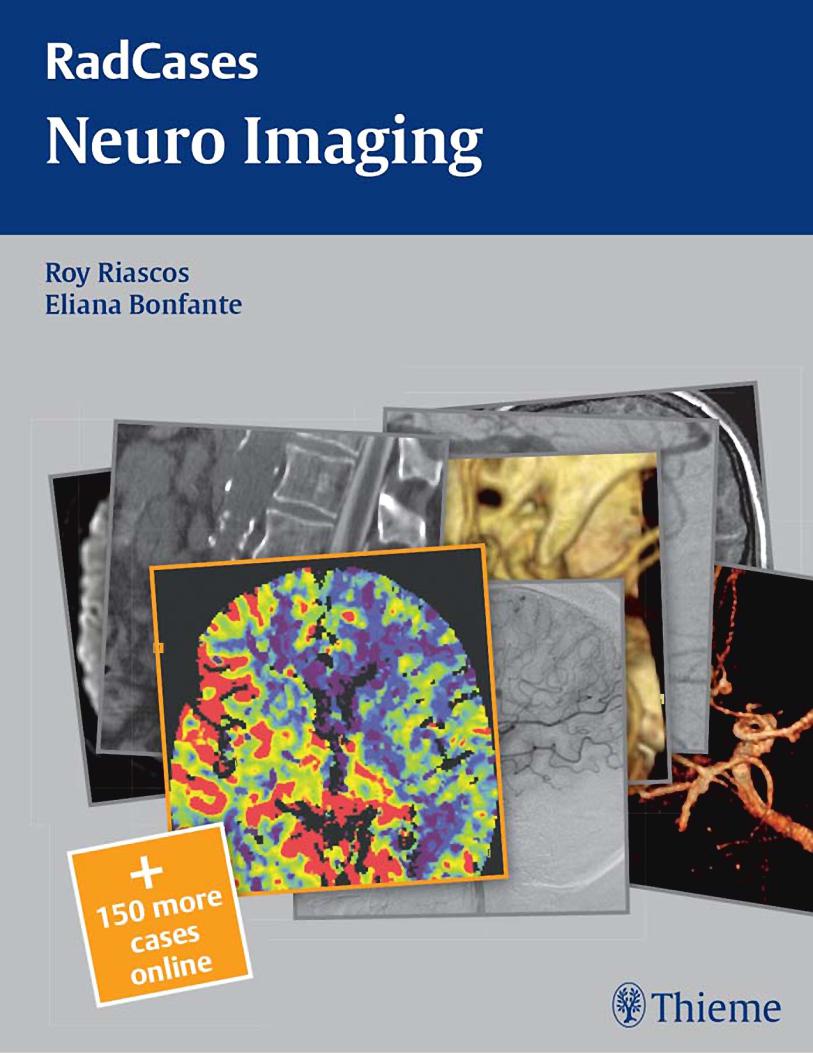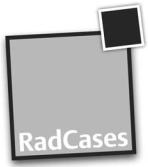
Книги по МРТ КТ на английском языке / Neuro Imaging Redcases
.pdf

Neuro Imaging

Neuro Imaging
Edited by
Roy Riascos, MD
Associate Professor of Radiology
Department of Radiology
The University of Texas Medical Branch
Galveston, Texas
Eliana Bonfante, MD
Assistant Professor
Department of Diagnostic and Interventional Imaging
University of Texas Medical School at Houston
Houston, Texas
Series Editors
Jonathan Lorenz, MD
Associate Professor of Radiology
Department of Radiology
The University of Chicago
Chicago, Illinois
Hector Ferral, MD
Professor of Radiology
Section Chief, Interventional Radiology
RUSH University Medical Center, Chicago
Chicago, Illinois
Thieme
New York • Stuttgart
Thieme Medical Publishers, Inc.
333 Seventh Ave.
New York, NY 10001
Executive Editor: Timothy Hiscock
Editorial Assistant: Adriana di Giorgio
Editorial Director: Michael Wachinger
Production Editor: Katy Whipple, Maryland Composition
International Production Director: Andreas Schabert
Vice President, International Marketing and Sales: Cornelia Schulze
Chief Financial O cer: James W. Mitos
President: Brian D. Scanlan
Compositor: MPS Content Services
Printer: Sheridan Press
Library of Congress Cataloging-in-Publication Data
Neuro imaging / edited by Roy F. Riascos and Eliana E. Bonfante. p. ; cm. — (RadCases)
Includes bibliographical references.
Summary: This book is not intended to teach neuroradiology—it is only a review of the most frequent pathologies and serves as a tool to be able to tell them apart. Of course, telling them apart is not always possible, and that is the whole trick of giving a pertinent set of di erential diagnoses and trying to favor one over the other. Our advice is to always look at the first image and try to describe as much as you can, as if it was the only image you had available, then go through the rest of the images and see if the thought process was similar. It would be impossible to include all the pertinent di erential diagnoses for each case with the format limitation of three di erential diagnoses per case. This way of teaching imaging analysis can both be similar to and very di erent from your daily clinical practice. Often, the pertinent finding or telltale sign to achieve a diagnosis lies in just a few of the images within an entire examination; however, you have to see the entire case and find these. Here, images that have been deemed key by someone else are selected, giving you the advantage of a focused search but the limitation of a narrow representation. You may find yourself frustrated by o ering a totally di erent di erential diagnosis from the one presented to you here, but be aware that the same case can have a completely di erent approach based on the way it is presented, the order of the images, or the finding in which you are focusing your process of thought. Additional references are provided to help you widen the scope of your review, especially in subjects that you may find more challenging or controversial—Provided by publisher.
ISBN 978-1-60406-189-5
1. Nervous system—Radiography—Case studies. I. Riascos, Roy F. II. Bonfante, Eliana E. III. Series: RadCases. [DNLM: 1. Central Nervous System Diseases—radiography—Case Reports. 2. Central Nervous System—
radiography—Case Reports. 3. Diagnostic Techniques, Neurological—Case Reports. WL 141 N4825 2010] RC349.R3N33 2010
616.8’047572―dc22
2010020830
Copyright © 2011 by Thieme Medical Publishers, Inc. This book, including all parts thereof, is legally protected by copyright. Any use, exploitation, or commercialization outside the narrow limits set by copyright legislation without the publisher’s consent is illegal and liable to prosecution. This applies in particular to photostat reproduction, copying, mimeographing or duplication of any kind, translating, preparation of microfilms, and electronic data processing and storage.
Important note: Medical knowledge is ever-changing. As new research and clinical experience broaden our knowledge, changes in treatment and drug therapy may be required. The authors and editors of the material herein have consulted sources believed to be reliable in their e orts to provide information that is complete and in accord with the standards accepted at the time of publication. However, in view of the possibility of human error by the authors, editors, or publisher of the work herein or changes in medical knowledge, neither the authors, editors, nor publisher, nor any other party who has been involved in the preparation of this work, warrants that the information contained herein is in every respect accurate or complete, and they are not responsible for any errors or omissions or for the results obtained from use of such information. Readers are encouraged to confirm the information contained herein with other sources. For example, readers are advised to check the product information sheet included in the package of each drug they plan to administer to be certain that the information contained in this publication is accurate and that changes have not been made in the recommended dose or in the contraindications for administration. This recommendation is of particular importance in connection with new or infrequently used drugs.
Some of the product names, patents, and registered designs referred to in this book are in fact registered trademarks or proprietary names even though specific reference to this fact is not always made in the text. Therefore, the appearance of a name without designation as proprietary is not to be construed as a representation by the publisher that it is in the public domain.
Printed in the United States
978-1-60406-189-5
To the woman for whom my heart surrenders, Maria Claudia, and our three sons, Camilo, Felipe, and Pablo, for making my life this wonderful experience.
—Roy Riascos
This book is dedicated to my loving and supporting soulmate, Darren, and to our two wonderful and inspiring children, Matthew and Zachary.
—Eliana Bonfante
RadCases Series Preface
The ability to assimilate detailed information across the entire spectrum of radiology is the Holy Grail sought by those preparing for the American Board of Radiology examination. As enthusiastic partners in the Thieme RadCases Series who formerly took the examination, we understand the exhaustion and frustration shared by residents and the families of residents engaged in this quest. It has been our observation that despite ongoing e orts to improve Web-based interactive databases, residents still find themselves searching for material they can review while preparing for the radiology board examinations and remain frustrated by the fact that only a few printed guidebooks are available, which are limited in both format and image quality. Perhaps their greatest source of frustration is the inability to easily locate groups of cases across all subspecialties of radiology that are organized and tailored for their immediate study needs. Imagine being able to immediately access groups of high-quality cases to arrange study sessions, quickly extract and master information, and prepare for theme-based radiology conferences. Our goal in creating the RadCases Series was to combine the popularity and portability of printed books with the adaptability, exceptional quality, and interactive features of an electronic case-based format.
The intent of the printed book is to encourage repeated priming in the use of critical information by providing a portable group of exceptional core cases that the resident can master. The best way to determine the format for these cases was to ask residents from around the country to weigh in. Overwhelmingly, the residents said that they would prefer a concise, point-by-point presentation of the Essential Facts of each case in an easy-to-read, bulleted format. This approach is easy on exhausted eyes and provides a quick review of Pearls and Pitfalls as information is absorbed during repeated study sessions. We worked hard to choose cases that could be presented well in this format, recognizing the limitations inherent in reproducing high-quality images in print. Unlike the authors of other case-based radiology re-
view books, we removed the guesswork by providing clear annotations and descriptions for all images. In our opinion, there is nothing worse than being unable to locate a subtle finding on a poorly reproduced image even after one knows the final diagnosis.
The electronic cases expand on the printed book and provide a comprehensive review of the entire subspecialty. Thousands of cases are strategically designed to increase the resident’s knowledge by providing exposure to additional case examples—from basic to advanced—and by exploring “Aunt Minnie’s,” unusual diagnoses, and variability within a single diagnosis. The search engine gives the resident a fighting chance to find the Holy Grail by creating individualized, daily study lists that are not limited by factors such as a radiology subsection. For example, tailor today’s study list to cases involving tuberculosis and include cases in every subspecialty and every system of the body. Or study only thoracic cases, including those with links to cardiology, nuclear medicine, and pediatrics. Or study only musculoskeletal cases. The choice is yours.
As enthusiastic partners in this project, we started small and, with the encouragement, talent, and guidance of Tim Hiscock at Thieme, continued to raise the bar in our e ort to assist residents in tackling the daunting task of assimilating massive amounts of information. We are passionate about continuing this journey, hoping to expand the cases in our electronic series, adapt cases based on direct feedback from residents, and increase the features intended for board review and self-assessment. As the American Board of Radiology converts its certifying examinations to an electronic format, our series will be the one best suited to meet the needs of the next generation of overworked and exhausted residents in radiology.
Jonathan Lorenz, MD
Hector Ferral, MD
Chicago, IL
Preface
This book is not intended to teach neuroradiology—it is only a review of the most frequent pathologies and serves as a tool to be able to tell them apart. Of course, telling them apart is not always possible, and that is the whole trick of giving a pertinent set of di erential diagnoses and trying to favor one over the other. Our advice is to always look at the first image and try to describe as much as you can, as if it was the only image you had available, then go through the rest of the images and see if the thought process was similar. It would be impossible to include all the pertinent di erential diagnoses for each case with the format limitation of three di erential diagnoses per case.
This way of teaching imaging analysis can both be similar to and very di erent from your daily clinical practice. Often, the pertinent finding or telltale sign to achieve a diagnosis lies in just a few of the images within an entire examination;
however, you have to see the entire case and find these. Here, images that have been deemed key by someone else are selected, giving you the advantage of a focused search but the limitation of a narrow representation. You may find yourself frustrated by o ering a totally di erent di erential diagnosis from the one presented to you here, but be aware that the same case can have a completely di erent approach based on the way it is presented, the order of the images, or the finding in which you are focusing your process of thought.
Additional references are provided to help you widen the scope of your review, especially in subjects that you may find more challenging or controversial.
We hope that with the interactive nature of this publication, you will have the chance to give us some feedback and help us improve and update this material on a frequent basis.
